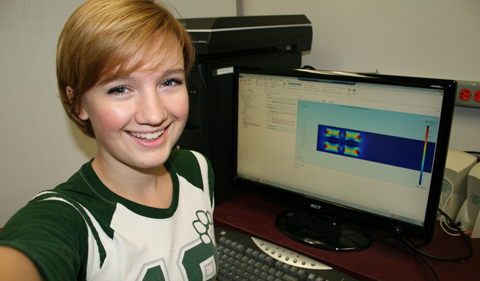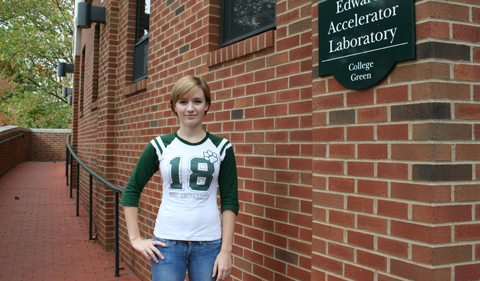By Erin Grimes
B.S. Physics and Mathematics, Class of 2016
I worked this summer with Dr. David Ingram, Professor of Physics at Ohio University, on a project to model ion beam optics of one of the beam lines of the accelerator in the Edwards Accelerator Laboratory.
As Dr. Ingram explained it, this particular beam line is where we hope to pass the ion beam into air rather than placing an object in a vacuum for the ion beam analysis. This can enable artifacts that are too delicate or too large to be put in a vacuum chamber to be analyzed in air. These could be works of art, archaeological or geological samples, or engineering samples too big to put in a vacuum chamber.
The ion beam exits the vacuum of the beam line through a thin silicon nitride window and travels up to several centimeters in air. When it hits the sample it generates X-rays or gamma rays that can enable elemental and even isotopic composition of the sample to be determined. This type of analysis is carried out at several well-known universities and museums such as the Louvre in Paris, Oxford University, Notre Dame, the key being the availability of an accelerator.
This was a great opportunity to learn how to work with COMSOL, a multiphysics software product. A challenge I had was getting my model to run studies on the magnetic field and particle tracing elements of my model and obtaining the expected results from those studies. I spent a lot of time finding and correcting errors in my model. COMSOL Inc. provided a lot of resources for their software, and I was able to work through most of my errors by practicing on simpler models from the model gallery and asking questions on the discussion forum and support center.
Dr. Ingram noted that the problem we have been addressing with our accelerator is that the beam optics were not designed to focus the ion beam on such a small point; most work on this beam line has required a defocused beam spot instead of a focused beam. With the help of the computer model that I built, we hope to optimize the position and operation of the magnets used to focus the beam to a sub-millimeter sized spot in contrast to the current beam, which is several millimeters.
I thought this internship was really interesting because it involved a lot of problem solving. By the end of the summer I was able to get a working model of the beam line that traces particle trajectories affected by the quadrupole magnets. All that’s left to do is to test the particle trajectories for different placements of the quadrupole magnets on the beam line and see if the magnets can be arranged in a way to get the desired result.
Erin Grimes – Intern with Dr. David Ingram – junior at Ohio University – College of Arts & Sciences – physics and mathematics major





















Comments